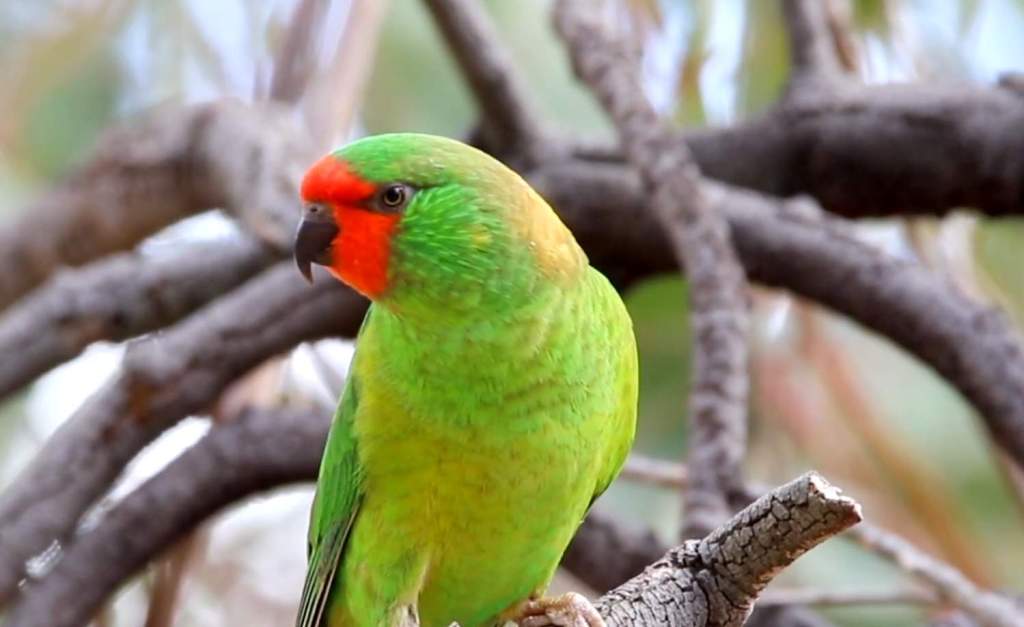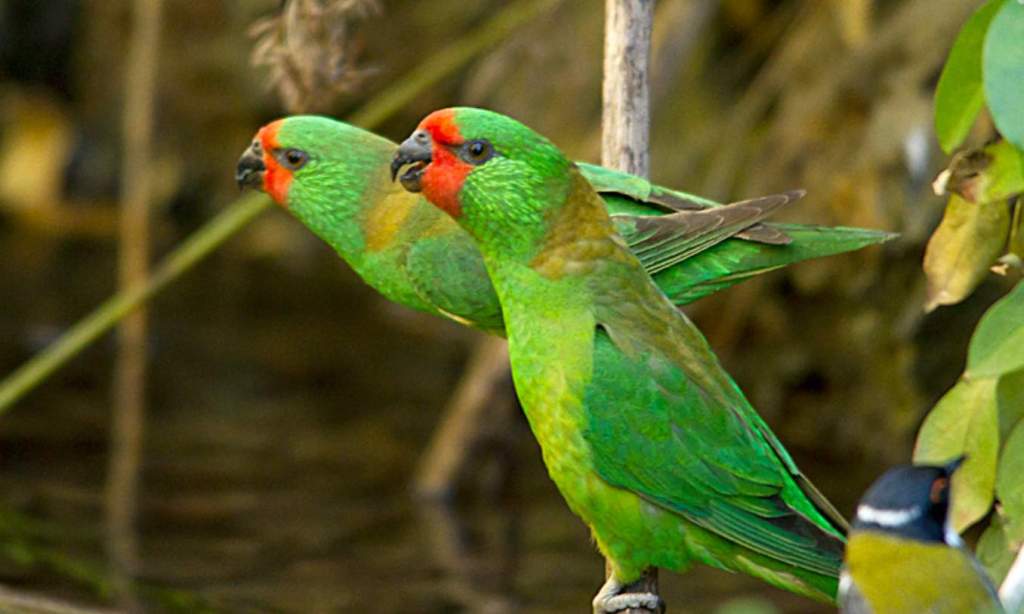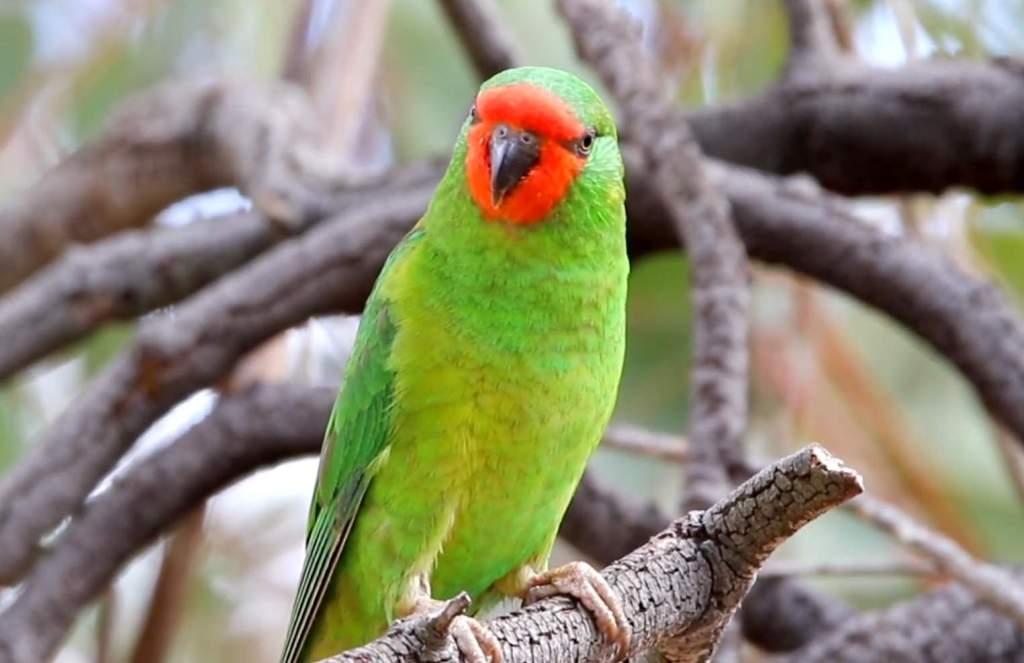Habitat: The Little Lorikeet (Parvipsitta pusilla) is a bird of the treetops. This little parrot moves among the leaves with a remarkable degree of agility, just like other lorikeets. Despite its small size and predominant green color, it is the most difficult bird to spot in its natural habitat. The little lorikeets generally stay in small groups and are often accompanied by other species of lorikeets, but sometimes flocks of lorikeets gather if eucalypts are in bloom.
The rainbow lorikeet is sociable and often finds himself in flocks with musk, purple-crowned, and musk lorikeets. It is extremely rare to see this parrot outside its native Australia even if it is found there. In spite of the fact that it is a difficult bird to keep in captivity. Sometimes Little Lorikeets can be found in logged forests and remnants of open forests, as well as in parks and gardens in urban areas.

Diet: They feed on pollen, nectar, blossoms, native and cultivated fruits, and seeds, mopping up nectar and pollen with their brush-tipped tongues. Often, the birds visit orchards to feed on fruit, but they do not seem as troublesome as the larger lorikeets. They came together in smaller numbers than other lorikeets at set roosts. By day, they also disperse widely in search of blossoms, but if they find them, they stay much higher in the crowns of flowering trees. After rain, they will also bathe in the leaves.
Flight: They fly swiftly and directly, with rapid wing beats that produce a whirring sound. When flushed from a feeding tree, the birds generally weave through the treetops or pass through the trees along a river while flying high. In flight, they display yellow-green under their wings, distinguishing them from Purple-crowned Lorikeets.

Nest & Breed: A Little Lorikeet appears to mate permanently, each individual preening itself along with its mate at its roost camp after a day of feeding. Nests are usually excavated by both sexes fifteen meters above ground in small hollows of eucalyptus trees. As soon as the last of the clutch is laid, the female begins to incubate. By regurgitating, the male feeds her in the nest. Nesting and breeding usually take place between July and January, but nesting has been recorded as early as May in the north. The nest is located in a hollow of a living eucalypt, preferably near water. The preparation of hollows for laying is the same for both birds.
Identification: As adults, both sexes are alike. General plumage and wings are grass-colored, lighter on the underparts. The forehead and face are red. The nape and upper mantle are bronze-brown tinted with green. The tail is green. The outer tail feathers are orange-red. Underwing coverts are yellow-green. Eyes are orange-yellow. Bill and Cere are black. Feet and toes are green-grey, and claws are darker. The immature bird’s face is duller red than adults; its eyes are brown; its bill is dark olive-brown. The downy young is white-downed, dull-billed.

Eggs & Incubation: The bird lays 3 to 5 eggs; white; rounded, about 20 x 17 mm. Lay in a layer of wood dust at the bottom of the nest. The incubation period is about 22 days for females. Young leave the nest at five weeks and are independent within two.
Distribution: Sporadically distributed in eastern and southeastern Australia, north to the Atherton Tableland and west to the inland fringes of the Great Dividing Range and southeast of South Australia; vagrant to the South Australian Gulfs and Tasmania. Nomadic. Prefers open forest and timber along lowlands’ watercourses but also in mountain eucalypt forests.
Vocalization: The Little Lorikeet contact call is constantly heard in flight and is a high-pitched, short wheezing screech. During feeding, the birds chatter constantly.
Family: The little lorikeet is a parrot species in the family Psittaculidae in the order Psittaciformes.
Movement: It’s a nomadic bird, influenced by the season and food availability.
Races: There are no races.
Alternative Names: The bird is also known as Tiny Lorikeet, red-faced Lorikeet, Gizzie, Green Keet, Slit, Little Keet, and Jerryang.
Lifespan: When kept in captivity, little lorikeets can live 15 to 20 years, which is longer than their wild lifespan of 9 to 10 years.
Size: The Little Lorikeet is about 150-160 mm long, including a short acute tail.
Read More – Rainbow Lorikeet – A Bird That Will Capture Your Attention







